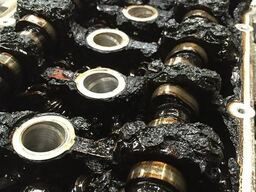 by P Sanchez It is said that performing oil change at OEM precribed intervals is perhaps the most important maintenance you can do to your car. Oil provides critical lubrication between surfaces that move against each other, avoiding heat and premature wear from friction. But how does engine oil get into those nook and crannies where they’re needed? Before, I’ve had a mechanically simplistic view that for oil to get to all the places needing lubrication, the crankcase of an engine had to be filled with oil to the brim, with all its moving parts fully submerged. Apparently, that’s not the case, as having free space is as important as having the right amount (and right age) of oil.  Back In The Old Days This animation created over 80 years ago beats out any modern day computer-generated 3D tutorial on how oil is circulated in the engine. As clearly shown and explained, oil is not only pumped to the different chambers of an engine but in most cases, oil is scooped, dripped, splashed, pressure sprayed, or allowed to flow over moving parts and mating surfaces. The engine achieves this oil circulation through a complex series of pumps, tubings, special openings, routes, and channels. So why not avoid all the mechanical complexity of getting lube to parts by simply filling the engine full of oil? Because oil is viscous, incompressible, and expands with heat, and it will impede the movement of major parts of the engine. Ever tried stirring a giant vat of thick soup with a ladel? As the wicked witch will attest, it takes a deal of effort. Now try to imagine stirring the soup several thousand RPMs and you’ll know I mean. In fact, forcefully operating an engine with its crankcase full of fluids - whether ovefilled with oil or water (like in cases where a car is submerged in deep floods) - may cause moving parts like the piston rods, to bend or break, and it may even cause the engine case to crack open because of pressure. So always keep with the manufacturer’s specification of how much oil to fill the engine. That “Retched” Feeling If overfilling the engine with oil is as bad as having not enough oil, why does starting an engine the worst for wear, even at proper oil levels? As the classic animation shows, oil is actively pumped and mechanically taken to parts needed when the engine is running. When an engine is off in any significant amount of time, oil simply drains away from the parts needing lubrication. So start-ups is like mechanical dry heaving for the engine, and most experts say it’s when most engine wear happen. Improvements in metallurgy, precision fitting, and especially advancements in oil chemistry has greatly mitigated engine wear during start-ups. Modern engine oil clings longer to metal surfaces providing some layer of protection during start-ups. Modern oil also retains their correct viscosity even in cold weather situation, allowing the engine to easily and quickly circulate it to parts needed once running. Oil also has other helpful properties like inhibiting corrosion as well as suspending any abrasive particulates for filtering. Sometimes, It’s Not Just Marketing. But alas, even the most technologically advanced oil formula does not retain its beneficial properties forever. Exposed to high heat and pressure, oil eventually breaks down, necesitating oil changes every interval. Again, frequency depends on manufacturer specification so check your car manual. If you feel that an annual oil change or every 3 to 5,000 miles is a bit of an exageration, check out this poor car. According to the shop mechanic hosting the video, the car is an 8 year old sedanr with 135 thousand miles which is as he pointed out, relatively low mileage given the car’s age. Incredibly, the car only receive an oil change once (or twice) in its life and it’s already showing signs of trouble (check engine lights). The teardown reveals how black oil sludge had already covered the camshaft assembly, the oil pan, and there was even sludge clinging to the crankshaft. The mechanic had to spray the insides of the engine with solvents and literally “spoon” off the gooey deposits with a screwdriver. Note that at one point of cleaning the removed camshafts, he had to inject solvent into tiny oil passageways in the shaft to unrestrict them. These holes are needed for the variable valve timing to operate correctly. Oil in this condition is “burnt”. It’s long hydrocarbon molecules - which give oil its characteristic viscosity and ability to form lubricating “film” between metal parts - have almost entirely oxidized, broken down to simpler molecules, and has little of its original lubricating property. Detergents and additives that “clean” and inhibit corrosion have probably been depleted, the oil filter clogged beyond function, and the oil itself is saturated with solid particulates (like carbon, metal filings fro wear, oxidized matter) which further exacerbates wear and clogging of sensitive components (such as the aforementioned camshaft oil passageways). Moral of the Story As the owner of the example car has probably learned, neglecting to do proper oil changes is an expensive mistake: what could have been just a $20 to $70 yearly oil change turned to a massive undertaking costing a few thousand dollars in parts and labor. Regularly change your oil, and for good measure, have a reputable auto repair shop do it correctly for you.
0 Comments
Leave a Reply. |
AuthorSmith's Auto Repair serves Dayton, Ohio and the surrounding communities using digital inspection service for all its customers ArchivesCategories |
 RSS Feed
RSS Feed